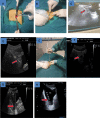Success rates and safety of a modified percutaneous PD catheter placement technique: Ultrasound-guided percutaneous placement of peritoneal dialysis catheters using a multifunctional bladder paracentesis trocar
- PMID: 35945766
- PMCID: PMC9351854
- DOI: 10.1097/MD.0000000000029694
Success rates and safety of a modified percutaneous PD catheter placement technique: Ultrasound-guided percutaneous placement of peritoneal dialysis catheters using a multifunctional bladder paracentesis trocar
Abstract
Background: We modified the blind Seldinger technique by incorporating ultrasound guidance and the use of a multifunctional bladder paracentesis trocar for PD catheter (PDC) placement, which can be easily performed by a nephrologist and is a feasible technique. To compare success rates and safety of our modified percutaneous PD catheter placement technique to open surgery.
Methods: Two hundred and twelve stage-5 chronic kidney disease(CKD) patients receiving PD therapy from June 2016 to June 2019 were included, 105 patients treated by ultrasound-guided percutaneous placement of peritoneal dialysis catheters using a multifunctional bladder paracentesis trocar (Group A) and 107 patients receiving open surgical placement (Group B). Outcomes of patients via either catheter placement technique were retrospectively compared. The clinical success rate as defined by proper catheter drainage within 4 weeks after placement, complication rates (both technical complications and infections), and 1-year catheter survival were compared.
Results: There was no significant difference in sex ratio, age, or previous abdominal surgery history between groups (P > .05). Both surgical time and incision length were significantly shorter in Group A than in Group B (P < .05). Clinical success rate was also higher inGroup A (P < .05). Moreover, Group A demonstrated lower overall complication rates (P < .05) and lower incidence rates of early peritonitis, initial drainage disorder, and peritubular leakage (all P < .05). One-year catheter survival was also higher in Group A (P < .05).
Conclusion: Percutaneous placement of PD catheters using our modified technique demonstrates superior success rates and safety compared to open surgery. In addition, our modified technique can be a better alternative to traditional Seldinger percutaneous catheterization for its higher success rate and safety, more accurate positioning.
Copyright © 2022 the Author(s). Published by Wolters Kluwer Health, Inc.
Conflict of interest statement
The authors have no funding and conflicts of interest to disclose.
Figures



Similar articles
-
Ultrasound-guided percutaneous peritoneal dialysis catheter insertion using multifunctional bladder paracentesis trocar: A modified percutaneous PD catheter placement technique.Semin Dial. 2020 Mar;33(2):133-139. doi: 10.1111/sdi.12862. Epub 2020 Mar 11. Semin Dial. 2020. PMID: 32160357 Free PMC article.
-
Comparison of Percutaneous and Open Surgical Techniques for First-Time Peritoneal Dialysis Catheter Placement in the Unbreached Peritoneum.Perit Dial Int. 2015 Sep-Oct;35(5):576-85. doi: 10.3747/pdi.2013.00003. Epub 2014 Jul 31. Perit Dial Int. 2015. PMID: 25082842 Free PMC article.
-
A half-percutaneous technique for peritoneal dialysis catheter implantation using a modified trocar: a report of 84 cases.Int Urol Nephrol. 2019 Aug;51(8):1451-1457. doi: 10.1007/s11255-019-02159-5. Epub 2019 May 22. Int Urol Nephrol. 2019. PMID: 31119517
-
The "Half-Perc" technique using a simple modified metal trocar for peritoneal dialysis catheter placement: results of a 3-year follow-up of 280 patients and a literature review.Int Urol Nephrol. 2022 Jul;54(7):1741-1749. doi: 10.1007/s11255-021-03028-w. Epub 2021 Nov 23. Int Urol Nephrol. 2022. PMID: 34813024 Review.
-
Percutaneous versus surgical insertion of PD catheters in dialysis patients: a meta-analysis.J Vasc Access. 2015 Nov-Dec;16(6):498-505. doi: 10.5301/jva.5000439. Epub 2015 Jun 29. J Vasc Access. 2015. PMID: 26165817 Review.
Cited by
-
Comparative outcomes of image-guided percutaneous catheterization versus direct visualization catheterization for peritoneal dialysis: A meta-analysis.PLoS One. 2025 Jul 7;20(7):e0325600. doi: 10.1371/journal.pone.0325600. eCollection 2025. PLoS One. 2025. PMID: 40622991 Free PMC article.
References
-
- Crabtree JH, Chow KM. Peritoneal dialysis catheter insertion. Semin Nephrol. 2017;37:17–29. - PubMed
-
- Yang PJ, Lee CY, Yeh CC, et al. . Mini-laparotomy implantation of peritoneal dialysis atheters: outcome and rescue. Perit Dial Int. 2010;30:513–8. - PubMed
-
- Schmidt SC, Pohle C, Langrehr JM, et al. . Laparoscopic-assisted placement of peri-toneal dialysis catheters:implantation technique and results. Laparoendosc Adv Surg Tech A. 2007;17:596–599. - PubMed
MeSH terms
LinkOut - more resources
Full Text Sources
Medical

